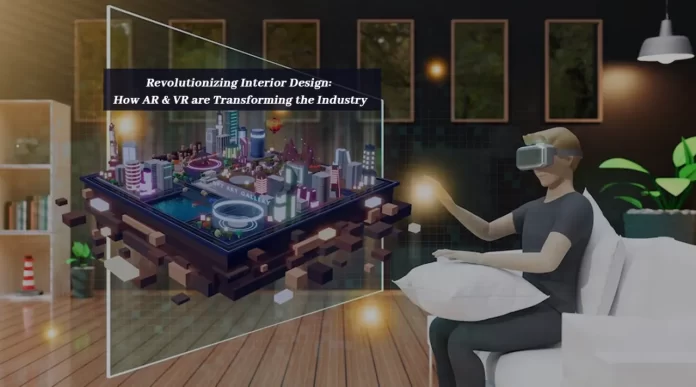Interior design is a discipline that involves the thoughtful arrangement and styling of interior spaces to create an aesthetically pleasing and functional environment. This art goes beyond the visual appeal; it aims to improve the user experience by better managing the space available, enhancing the room’s functionality, and maximizing comfort. interior design plays a part in setting the ambiance of a space, reflecting personal style, housing technology, and even promoting sustainability.
The integration of technology in the field of interior design has become undeniable. Technology has a transformative effect on interior design strategies, from the use of advanced digital design tools to the incorporation of smart home features. The use of technology in an interior design studio doesn’t only enhance visual communication but also facilitates decision-making processes. Therefore, understanding the relationship between technology and interior design is significant for any forward-thinking designer, enthusiast, or homeowner aiming to create spaces that resonate with the digital age.
Table of Contents
Progression of Technology in Interior Design
The rise of technology in interior design has transformed the scene of this creative field from traditional to digital. In the early days, interior designers relied heavily on drawings and paper blueprints to design spaces. These methods, albeit artistic, were time-consuming and left a lot of room for error. Interior design studios were marked with drafting tables, t-squares, and drawing boards as the key tools of trade. As technology began to change, so did the methods of designing. Interior designers started using computer-aided design (CAD) to conceive and render their ideas which was a big leap from manual drafting, significantly improving accuracy and efficiency.
Advanced software and applications like SketchUp, Revit, and AutoCAD have become staples in an interior designer’s toolkit, enabling them to create more detailed and realistic visuals, almost transforming ideas into reality before actual execution. The advent of augmented reality (AR) and virtual reality (VR) technologies now allows designers and clients to virtually step into their designed spaces, thus facilitating informed decision-making. These are just a few examples of technology’s profound impact on modern interior design. As technology continues to change, so will its contribution to this dynamic field.
The Impact of Digital Design Tools
Digital design tools have dramatically transformed the world of interior design, offering myriad options for visualizing and creating spaces effectively. These tools come in various forms, each with its unique features and uses. For instance, Computer-Aided Design (CAD) software, like SketchUp and AutoCAD, allows designers to carry out much detailed, two-dimensional and three-dimensional design work. Furthermore, advanced rendering tools, such as 3ds Max and V-Ray, make it possible to create photorealistic images of designs. Augmented reality (AR) and virtual reality (VR) technologies help visualize designs in a real-world setting, providing a life-like experience even before the actual implementation.
Digital design tools not only enhance precision in design planning but also offer greater visualization capabilities and efficient time management. With these tools, interior designers can easily alter their designs, try out different ideas, and provide clients with a realistic representation of the end product, hence minimizing the risk of disappointing outcomes.
Augmented Reality and Virtual Reality in Interior Design
Augmented Reality (AR) and Virtual Reality (VR) are immersive technologies that are reshaping various industries, including interior design. AR is a groundbreaking technology that superimposes a computer-generated image on a user’s view of the real world, providing a composite view. On the other hand, VR creates a simulated environment that immerses the user, closing off the physical world and replacing it with a completely virtual experience.
In the world of interior design, the integration of AR and VR technologies is creating transformative client experiences. AR apps, for instance, can demonstrate what a particular piece of furniture would look like in a specific setting, just by pointing a device’s camera to space. VR, conversely, offers immersive walkthroughs of computationally designed spaces, allowing both designers and clients to experience a room before it is built physically. This not only reduces the guesswork typically associated with space design but also aids in accurate decision making and efficient planning.
Smart Homes and Interior Design
Smart homes represent the epitome of modern living, where automation and interconnectivity between devices enhance the convenience and efficiency of daily tasks. Simply put, a smart home is a setup where appliances and devices like lighting, heating, and electronic gadgets are connected to a common system, which can be controlled remotely or operate autonomously through preset guidelines.
The influence of smart home technology on interior design is profound. It has a considerable impact on the aesthetics and function of interior spaces. Smart home features such as automated lighting, sensors, advanced home security systems, and digital artwork displays contribute to a modern aesthetic while enhancing functionality. These technological installations are designed to blend with the interiors seamlessly, preserving the visual appeal while boosting user convenience.
Interior designers today are continuously working to integrate smart home features to provide clients with more interactive and easy-to-live-in spaces. For instance, they are embedding voice-activated devices into living areas for hands-free convenience, using smart lighting that adjusts to mood settings, or incorporating digital wall displays that can change the look and feel of a room in an instant. This seamless inclusion of smart home features in their design strategies results in functional, comfortable, and cutting-edge modern homes.
The function of technology in modern interior design is both groundbreaking and transformative. It not only offers endless possibilities for creative expression but also empowers designers to craft functional, efficient, and eco-friendly living spaces. As we continue to embrace these advancements, the future of interior design holds promise for a dynamic convergence of technology, sustainability, and aesthetic flair.
















